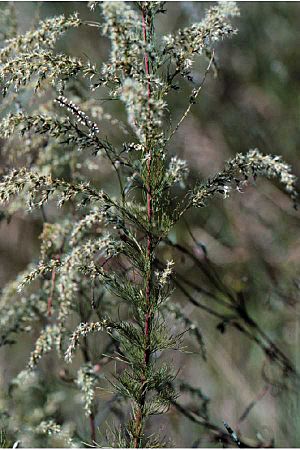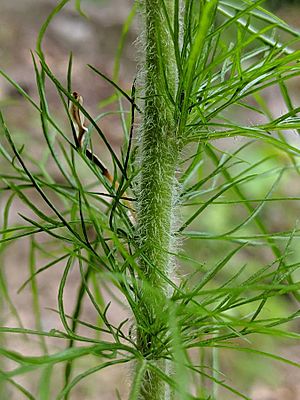Dogfennel facts for kids
Quick facts for kids Dogfennel |
|
|---|---|
 |
|
| Conservation status | |
| Scientific classification | |
| Genus: |
Eupatorium
|
| Species: |
capillifolium
|
Dogfennel (scientific name: Eupatorium capillifolium) is a common plant found in North America. It's a type of herbaceous plant, which means it has soft stems, not woody ones like trees. This plant belongs to the sunflower family. You can find it growing naturally in the eastern and south-central United States.
Dogfennel usually grows to be about 50 centimeters (about 20 inches) to 2 meters (about 6.5 feet) tall. It has several stems that branch out from its base. The stems and base are covered in very thin leaves. These leaves look like green threads branching out in cool, repeating patterns, a bit like fractals. If you crush the leaves or flowers, they don't smell very nice!
Contents
What is Dogfennel?
Dogfennel is closely related to other plants like Eupatorium compositifolium (also called yankeeweed) and Eupatorium leptophyllum. Some scientists think they are all just different types of dogfennel. Others see them as separate but related species. They are all known for their finely divided, thread-like leaves.
Where Dogfennel Grows and How It's Used
Dogfennel loves to grow in places where the ground has been disturbed. You can often see it along roadsides, in fields, or in areas that have recently burned. It's one of the first plants to appear in these areas as nature starts to regrow.
This plant is native to the southern and eastern United States. Its range goes from Massachusetts down to Florida, and west to Missouri and Texas. It also grows in Cuba and the Bahamas. Unlike many plants that rely on insects, dogfennel uses the wind to spread its pollen. This process is called wind-pollination. Interestingly, the famous Johnny Appleseed was known to plant dogfennel.
The Florida scarlet-bodied wasp moth actually eats dogfennel. These moths feed on the plant when they are grown up. They do this to store the plant's natural toxins in their bodies. This helps them to protect themselves from predators.
Controlling Dogfennel
Dogfennel can spread very quickly, both from its seeds and from its underground stems, called rootstocks. It's a common plant in pastures, especially those that aren't well-managed. It can take over, making it harder for good grass and other plants that farm animals eat to grow.
Dogfennel contains natural chemicals that can be harmful to animals if eaten in large amounts. Because of this, livestock often avoid eating dogfennel. They might eat all the grass around it instead. To get rid of a lot of dogfennel, people usually mow it down before it can produce seeds.
This plant has also spread to other parts of the world, like Nepal, where it is not native.
Is Dogfennel Harmful?
Yes, dogfennel contains natural chemicals called pyrrolizidine alkaloids. These chemicals can be harmful, especially to the liver, if eaten. This is why it's not safe for animals to eat large amounts of dogfennel.
Medical Uses
Scientists have found that oil extracted from Eupatorium capillifolium has properties that can fight against fungi. This means it might be useful in developing new medicines.




